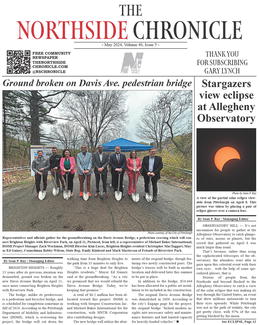St. Nicholas denied permission to demolish church
Normal
0
false
false
false
EN-US
X-NONE
X-NONE
/* Style Definitions */
table.MsoNormalTable
{mso-style-name:”Table Normal”;
mso-style-parent:””;
font-size:11.0pt;”Calibri”,”sans-serif”;
mso-fareast-“Times New Roman”;}
For the time being, the empty and historic St. Nicholas church building in Troy Hill will remain standing along Route 28.
This week The Pittsburgh Historic Review Commission denied current building owners St. Nicholas parish, now located in Millvale, a demolition permit to tear down their old building in Troy Hill because the church has city historic status. The decision will next go to the city planning commission and then to city council.
The parish is now looking at other options for the site, which include appealing the commission’s decision or selling the old church to The Northside Leadership Conference, who would turn the building into an immigrant museum.
“We’ve had an initial chat and we covered a wide range of issues. We’re in agreement on many of them.” said NSLC Executive Director Mark Fatla. “There’s a whole plan for the redevelopment of the property as an immigrant museum,”
“I believe that the best thing we could do right now, would be to demolish it. But I’m not against selling it either,” said Rev. Dan Whalen, of St. Nicholas Church, who noted that the empty building is a financial drain on the church each month.
He said the diocese lawyers are currently working to file for a certificate of economic hardship to obtain the permit to demolish the building.
If the building is demolished, St Nicholas hopes to sell the land to PennDOT, who want to widen a narrow stretch of Route 28 that the church is currently obstructing.
The problem is that St. Nicholas Church is on a slippery slope, both literally and financially.
The parish is now located in Millvale, where they only have around 225 regular parishioners and not enough money to maintain two historical buildings.
The Northside building has cost the church $370,000 since 2004 when the building closed, and Father Whalen estimates that currently 20 to 25 percent of offertory funds go into maintaining the old church.
“We just don’t have the money,” said Father Whalen, who noted that their Millvale location was on the national and city register of historic places and is the home of the parish’s famous murals.
“The church in Millvale is worth saving, and that’s what we’re trying to do,” said Father Whalen.
The hill that the church sits on, which was once the site of a since-gone Croatian community, is also a potential problem.
When St. Nicholas first considered selling the building, the engineer they hired told them the hill was collapsing onto the church and could potentially threaten the building.
“As responsible citizens, we couldn’t just sit on that,” Father Whalen said. “We have to do something to alleviate that problem… God forbid something happen.”
Father Whalen said the church simply does not have the money to fix the hillside.
When the NSLC began talks with the church about buying the building, they also hired an engineer who refuted the severity of the hillside problem.
Though the church closed in 2004, plans to close it had been in the works since 2000, because the Northside’s St. Nicholas church could not financially support itself. The plan was to converge with its sister church in Millvale.
Despite the pending closure, several church members applied for the church building to be a registered historic site, against the wishes of the parish in 2001.
“The bishop pointedly stated that they did not want it to be designated as a historic site,” said Whalen.
Whalen said that since St. Nicholas became a historic site in 2001, the law has since changed and does not allow properties to become historic sites without the owner’s consent.
Another issue addressed is that the next use of the church, if it remains standing, would need to be appropriate from the church’s perspective.
“A museum would certainly be an acceptable use,” said Father Whalen.





